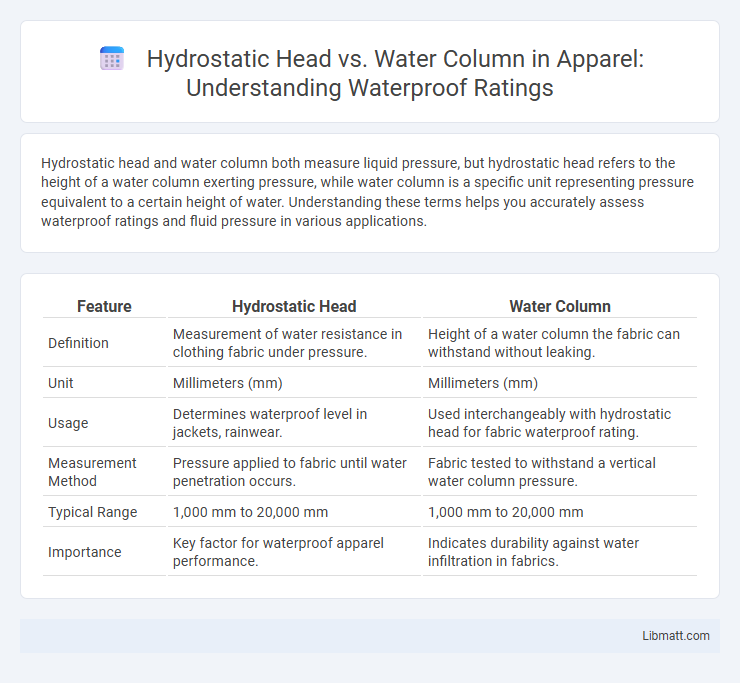Hydrostatic head and water column both measure liquid pressure, but hydrostatic head refers to the height of a water column exerting pressure, while water column is a specific unit representing pressure equivalent to a certain height of water. Understanding these terms helps you accurately assess waterproof ratings and fluid pressure in various applications.
Table of Comparison
| Feature | Hydrostatic Head | Water Column |
|---|---|---|
| Definition | Measurement of water resistance in clothing fabric under pressure. | Height of a water column the fabric can withstand without leaking. |
| Unit | Millimeters (mm) | Millimeters (mm) |
| Usage | Determines waterproof level in jackets, rainwear. | Used interchangeably with hydrostatic head for fabric waterproof rating. |
| Measurement Method | Pressure applied to fabric until water penetration occurs. | Fabric tested to withstand a vertical water column pressure. |
| Typical Range | 1,000 mm to 20,000 mm | 1,000 mm to 20,000 mm |
| Importance | Key factor for waterproof apparel performance. | Indicates durability against water infiltration in fabrics. |
Understanding Hydrostatic Head
Hydrostatic head measures the pressure exerted by a column of water, typically expressed in units like millimeters or inches of water column (mmH2O or inH2O). This value helps determine water resistance and waterproofing levels in materials, crucial for evaluating products exposed to moisture or rain. When assessing your gear's water resistance, understanding the hydrostatic head provides insight into how much water pressure the material can withstand without leaking.
Defining Water Column
Water column refers to the vertical measurement of water pressure exerted over a specific height, typically expressed in millimeters or centimeters of water (mmH2O or cmH2O). This metric represents the hydrostatic pressure caused by the weight of a water column above a point, serving as a standard for evaluating waterproofing performance in fabrics and materials. Unlike hydrostatic head measured in millimeters (mm), water column focuses specifically on the pressure generated by water height, providing a practical indicator of resistance to water penetration.
Key Differences: Hydrostatic Head vs Water Column
Hydrostatic head measures the pressure exerted by a fluid column based on the height of the fluid above a specific point, typically expressed in meters or feet. Water column, on the other hand, is a direct measurement of pressure in units of length, representing the height of water that produces equivalent pressure, often used in contexts such as waterproof ratings. Understanding the distinction helps you accurately interpret material resistance to water penetration and pressure in applications like outdoor gear and plumbing systems.
Importance in Waterproof Materials
Hydrostatic head and water column are critical metrics for assessing the waterproof performance of materials, indicating their ability to withstand water pressure over time. A higher hydrostatic head value means better water resistance, essential for outdoor gear like jackets, tents, and footwear to keep you dry in heavy rain. Manufacturers rely on these measurements to ensure products meet durability standards against water penetration in various environmental conditions.
Measurement Techniques for Hydrostatic Head
Hydrostatic head is measured using pressure sensors or manometers that quantify the height of a water column exerting pressure on a surface. This measurement technique assesses water resistance by calculating the force per unit area from a standing water column, expressed in millimeters or inches of water. Your accurate evaluation depends on choosing the appropriate device that correlates the water column height directly with hydrostatic pressure for reliable waterproofing and material testing.
Water Column Testing Methods
Water column testing methods measure the height of a water column that a material can withstand before leaking, providing a direct indicator of water resistance. Hydrostatic head testing quantifies the pressure exerted by water on a fabric, often expressed in millimeters, to evaluate waterproof performance under static conditions. Understanding these testing metrics helps you select materials with reliable water resistance for outdoor gear or construction applications.
Industry Standards and Ratings
Hydrostatic head and water column are crucial metrics in industry standards for waterproof materials, with hydrostatic head measured in millimeters and representing the pressure a fabric can withstand before water penetrates. Industry ratings often specify a minimum hydrostatic head, such as 1,000 mm for water resistance, ensuring your gear meets performance requirements for specific environmental conditions. Water column measurements correlate directly with hydrostatic head values, standardizing fabric testing across outdoor and protective clothing sectors to guarantee reliable waterproof ratings.
Applications in Outdoor Gear and Construction
Hydrostatic head and water column measurements both assess fabric waterproofness, with hydrostatic head commonly used in outdoor gear like tents and rain jackets to ensure reliable protection against water penetration during intense weather. Water column tests apply in construction materials such as roofing membranes and waterproof barriers, helping evaluate their durability against static water pressure. You can choose the best material by comparing these metrics to match specific environmental demands and ensure long-lasting waterproof performance.
Interpreting Test Results
Hydrostatic head and water column are measurements used to assess waterproofing performance, with hydrostatic head expressed in millimeters or inches representing the height of a water column that a material can withstand before leaking. Interpreting test results involves understanding that higher values indicate better resistance to water penetration under pressure, crucial for outdoor gear and construction materials. Your ability to evaluate product ratings accurately depends on recognizing these values and their implications for real-world water exposure.
Choosing the Right Metric for Your Needs
Hydrostatic head and water column are both measurements of water resistance commonly used in waterproof fabrics, with hydrostatic head expressed in millimeters indicating the height of a water column a material can withstand before leaking. Selecting the appropriate metric depends on the application, where higher hydrostatic head values are critical for outdoor gear exposed to heavy rain, while water column measures provide a straightforward understanding of material performance for less demanding conditions. Understanding the differences ensures accurate evaluation of waterproof ratings to match specific needs, such as hiking, boating, or everyday wear.
hydrostatic head vs water column Infographic

 libmatt.com
libmatt.com